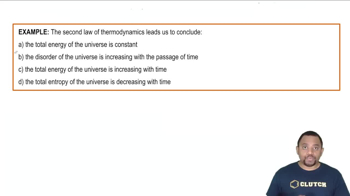Dinitrogen tetroxide decomposes to nitrogen dioxide: N2O4(g) → 2 NO2(g) ΔH°rxn = 55.3 kJ At 298 K, a reaction vessel initially contains 0.100 atm of N2O4. When equilibrium is reached, 58% of the N2O4 has decomposed to NO2. What percentage of N2O4 decomposes at 388 K? Assume that the initial pressure of N2O4 is the same (0.100 atm).
Ch.18 - Free Energy and Thermodynamics
Chapter 18, Problem 99a
Indicate and explain the sign of ΔSuniv for each process. a. 2 H2(g) + O2(g) → 2 H2O (l) at 298 K.
 Verified step by step guidance
Verified step by step guidance1
Step 1: Understand the concept of entropy (ΔS). Entropy is a measure of the randomness or disorder of a system. The second law of thermodynamics states that the total entropy of an isolated system can never decrease over time, and is constant if and only if all processes are reversible. Isolated systems spontaneously evolve towards thermodynamic equilibrium, the state with maximum entropy.
Step 2: Identify the state of the reactants and products. In this reaction, gaseous reactants (2 H2 and O2) are converted into a liquid product (2 H2O).
Step 3: Consider the change in entropy of the system (ΔSsys). The conversion of gas molecules to liquid molecules results in a decrease in randomness, as molecules in a liquid are more ordered than in a gas. Therefore, the entropy of the system decreases (ΔSsys is negative).
Step 4: Consider the change in entropy of the surroundings (ΔSsurr). The reaction is exothermic, meaning it releases heat into the surroundings. This increases the randomness of the surroundings, so the entropy of the surroundings increases (ΔSsurr is positive).
Step 5: Calculate the total change in entropy (ΔSuniv = ΔSsys + ΔSsurr). If the increase in entropy of the surroundings is greater than the decrease in entropy of the system, the total entropy of the universe increases (ΔSuniv is positive), and the process is spontaneous. If not, the total entropy of the universe decreases (ΔSuniv is negative), and the process is non-spontaneous. In this case, you would need to calculate the specific values of ΔSsys and ΔSsurr to determine the sign of ΔSuniv.

Verified video answer for a similar problem:
This video solution was recommended by our tutors as helpful for the problem above.
Video duration:
2mWas this helpful?
Key Concepts
Here are the essential concepts you must grasp in order to answer the question correctly.
Entropy (ΔS)
Entropy is a measure of the disorder or randomness in a system. In thermodynamics, a positive change in entropy (ΔS > 0) indicates an increase in disorder, while a negative change (ΔS < 0) signifies a decrease in disorder. Understanding how entropy changes during a chemical reaction is crucial for predicting the spontaneity of the process.
Recommended video:
Guided course

Entropy in Thermodynamics
Second Law of Thermodynamics
The Second Law of Thermodynamics states that the total entropy of an isolated system can never decrease over time. It implies that natural processes tend to move towards a state of maximum disorder or entropy. This law is fundamental in determining the sign of the change in the universe's entropy (ΔS_univ) during a reaction, as it combines the entropy changes of both the system and its surroundings.
Recommended video:
Guided course

Second Law of Thermodynamics Example
Gibbs Free Energy (ΔG)
Gibbs Free Energy is a thermodynamic potential that helps predict the direction of chemical reactions and phase changes. It is defined as ΔG = ΔH - TΔS, where ΔH is the change in enthalpy, T is the temperature in Kelvin, and ΔS is the change in entropy. A negative ΔG indicates a spontaneous process, which is closely related to the signs of ΔS and ΔH, making it essential for analyzing the reaction's feasibility.
Recommended video:
Guided course

Gibbs Free Energy of Reactions
Related Practice
Textbook Question
Textbook Question
A metal salt with the formula MCl2 crystallizes from water to form a solid with the composition MCl2 • 6 H2O. The equilibrium vapor pressure of water above this solid at 298 K is 18.3 mmHg. What is the value of ΔG for the reaction MCl2 • 6 H2O(s) ⇌ MCl2(s) + 6 H2O(g) when the pressure of water vapor is 18.3 mmHg? When the pressure of water vapor is 760 mmHg?
Textbook Question
The solubility of AgCl(s) in water at 25 °C is 1.33⨉10-5 mol/L and its ΔH° of solution is 65.7 kJ/mol. What is its solubility at 50.0 °C?
